Optical Trapping and Manipulating with a Silica Microring Resonator in a Self-Locked Scheme
Abstract
1. Introduction
2. Materials and Methods
3. Simulation
4. Results and Discussion
5. Conclusions
Supplementary Materials
Author Contributions
Funding
Acknowledgments
Conflicts of Interest
References
- Ashkin, A.; Dziedzic, J.M.; Yaman, T. Optical trapping and manipulation of single cells using infrared laser beams. Nature 1987, 330, 769–771. [Google Scholar] [CrossRef] [PubMed]
- Wang, M.M.; Tu, E.; Raymond, D.E.; Yang, J.M.; Zhang, H.C.; Hagen, N.; Dees, B.; Mercer, E.M.; Forster, A.H.; Kariv, I.; et al. Microfluidic sorting of mammalian cells by optical force switching. Nat. Biotechnol. 2005, 23, 83–87. [Google Scholar] [CrossRef] [PubMed]
- Schmidt, B.S.; Yang, A.H.J.; Erickson, D.; Lipson, M. Optofluidic trapping and transport on solid core waveguides within a microfluidic device. Opt. Express 2007, 15, 14322–14334. [Google Scholar] [CrossRef]
- Yang, A.H.J.; Lerdsuchatawanich, T.; Erickson, D. Forces and Transport Velocities for a Particle in a Slot Waveguide. Nano Lett. 2009, 9, 1182–1188. [Google Scholar] [CrossRef] [PubMed]
- Cai, H.; Poon, A.W. Optical manipulation and transport of microparticle on silicon nitride microring resonator—Based add-drop devices. Opt. Lett. 2010, 35, 2855–2857. [Google Scholar] [CrossRef] [PubMed]
- Chen, Y.F.; Serey, X.; Sarkar, R.; Chen, P.; Erickson, D. Controlled Photonic Manipulation of Proteins and Other Nanomaterials. Nano Lett. 2012, 12, 1633–1637. [Google Scholar] [CrossRef]
- Soltani, M.; Lin, J.; Forties, R.A.; Inman, J.T.; Saraf, S.N.; Fulbright, R.M.; Lipson, M.; Wang, M.D. Nanophotonic trapping for precise manipulation of biomolecular arrays. Nat. Nanotechnol. 2014, 9, 448–452. [Google Scholar] [CrossRef]
- Jiao, W.X.; Wang, G.H.; Ying, Z.F.; Zou, Y.; Ho, H.P.; Sun, T.Y.; Huang, Y.; Zhang, X.P. Switching of nanoparticles in large-scale hybrid electro-optofluidics integration. Opt. Lett. 2016, 41, 2652–2655. [Google Scholar] [CrossRef]
- Jiao, W.X.; Wang, G.H.; Ying, Z.F.; Kang, Z.W.; Sun, T.Y.; Zou, N.M.; Ho, H.P.; Zhang, X.P. Optofluidic Switching of Nanoparticles Based on a WDM Tree Splitter. IEEE Photonics J. 2016, 8. [Google Scholar] [CrossRef]
- Xu, X.F.; Dong, Y.M.; Wang, G.H.; Jiao, W.X.; Ying, Z.F.; Ho, H.P.; Zhang, X.P. Reconfigurable Sorting of Nanoparticles on a Thermal Tuning Silicon Based Optofluidic Chip. IEEE Photonics J. 2017, 10. [Google Scholar] [CrossRef]
- Xu, X.F.; Wang, G.H.; Jiao, W.X.; Ji, W.B.; Jiang, M.; Zhang, X.P. Multi-level sorting of nanoparticles on multi-step optical waveguide splitter. Opt. Express 2018, 26, 29262–29271. [Google Scholar] [CrossRef] [PubMed]
- Xu, W.H.; Wang, Y.Y.; Jiao, W.X.; Wang, F.; Xu, X.F.; Jiang, M.; Ho, H.P.; Wang, G.H. Tunable optofluidic sorting and manipulation on micro-ring resonators from a statistics perspective. Opt. Lett. 2019, 44, 3226–3229. [Google Scholar] [CrossRef] [PubMed]
- An, R.; Wang, G.H.; Ji, W.B.; Jiao, W.X.; Jiang, M.; Chang, Y.; Xu, X.F.; Zou, N.M.; Zhang, X.P. Controllable trapping and releasing of nanoparticles by a standing wave on optical waveguides. Opt. Lett. 2018, 43, 3901–3904. [Google Scholar] [CrossRef] [PubMed]
- Ye, F.; Badman, R.P.; Inman, J.T.; Soltani, M.; Killian, J.L.; Wang, M.D. Biocompatible and High. Stiffness Nanophotonic Trap Array for Precise and Versatile Manipulation. Nano Lett. 2016, 16, 6661–6667. [Google Scholar] [CrossRef]
- Ye, F.; Soltani, M.; Inman, J.T.; Wang, M.D. Tunable nanophotonic array traps with enhanced force and stability. Opt. Express 2007, 25, 7907–7918. [Google Scholar] [CrossRef]
- Badman, R.P.; Ye, F.; Caravan, W.; Wang, M.D. High Trap Stiffness Microcylinders for Nanophotonic Trapping. ACS Appl. Mater. Interfaces 2019, 11, 25074–25080. [Google Scholar] [CrossRef]
- Lin, S.; Schonbrun, E.; Crozier, K. Optical Manipulation with Planar Silicon Microring Resonators. Nano Lett. 2010, 10, 2408–2411. [Google Scholar] [CrossRef]
- Vollmer, F.; Arnold, S. Whispering-gallery-mode biosensing: Label-free detection down to single molecules. Nat. Methods 2008, 5, 591–596. [Google Scholar] [CrossRef]
- Zhu, J.; Ozdemir, S.K.; Xiao, Y.F.; Li, L.; He, L.; Chen, D.R.; Yang, L. On-chip single nanoparticle detection and sizing by mode splitting in an ultrahigh-Q microresonator. Nat. Photonics 2010, 4, 46–49. [Google Scholar] [CrossRef]
- Mandal, S.; Serey, X.; Erickson, D. Nanomanipulation Using Silicon Photonic Crystal Resonators. Nano Lett. 2010, 10, 99–104. [Google Scholar] [CrossRef]
- Peccianti, M.; Pasquazi, A.; Park, Y.; Little, B.E.; Chu, S.T.; Moss, D.J.; Morandotti, R. Demonstration of a stable ultrafast laser based on a nonlinear microcavity. Nat. Commun. 2012, 3, 765. [Google Scholar] [CrossRef] [PubMed]
- Baker, J.E.; Badman, R.P.; Wang, M.D. Nanophotonic trapping: Precise manipulation and measurement of biomolecular arrays. WIREs Nanomed. Nanobiotechnol. 2018, 10, e1477. [Google Scholar] [CrossRef] [PubMed]
- Badman, R.P.; Ye, F.; Wang, M.D. Towards biological applications of nanophotonic tweezers. Curr. Opin. Chem. Biol. 2019, 53, 158–166. [Google Scholar] [CrossRef] [PubMed]
- Sun, Y.; Fan, X. Optical ring resonators for biochemical and chemical sensing. Anal. Bioanal. Chem. 2011, 399, 205–211. [Google Scholar] [CrossRef]
- Little, B.E.; Chu, S.T.; Haus, H.A.; Foresi, J.; Laine, J.P. Microring resonator channel dropping filters. J. Lightwave Technol. 1997, 15, 998–1005. [Google Scholar] [CrossRef]
- Wang, H.; Wu, X.; Shen, D. Localized optical manipulation in optical ring resonators. Opt. Express 2015, 23, 27650–27660. [Google Scholar] [CrossRef]
- Michaelides, E.E. Brownian movement and thermophoresis of nanoparticles in liquids. Int. J. Heat Mass Transf. 2015, 81, 179–187. [Google Scholar] [CrossRef]
- Blocken, B.; van Druenen, T.; Toparlar, Y.; Malizia, F.; Mannion, P.; Andrianne, T.; Marchal, T.; Maas, G.J.; Diepens, J. Aerodynamic drag in cycling pelotons: New insights by CFD simulation and wind tunnel testing. J. Wind Eng. Ind. Aerodyn. 2018, 179, 319–337. [Google Scholar] [CrossRef]
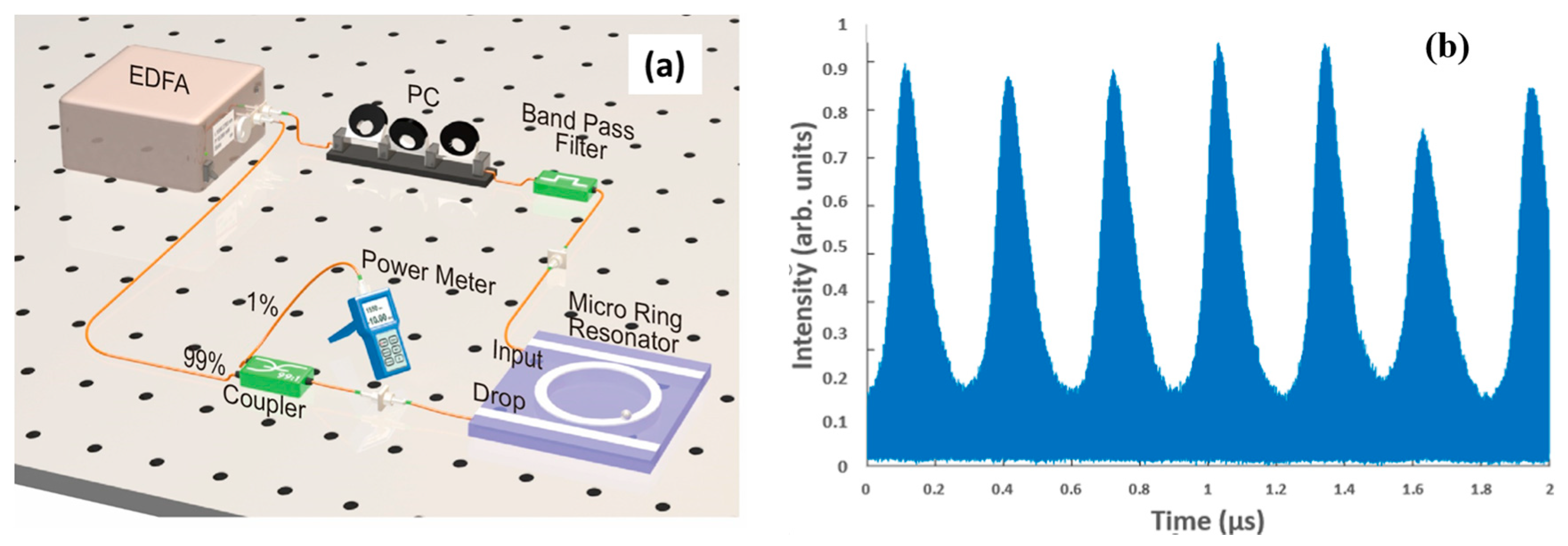
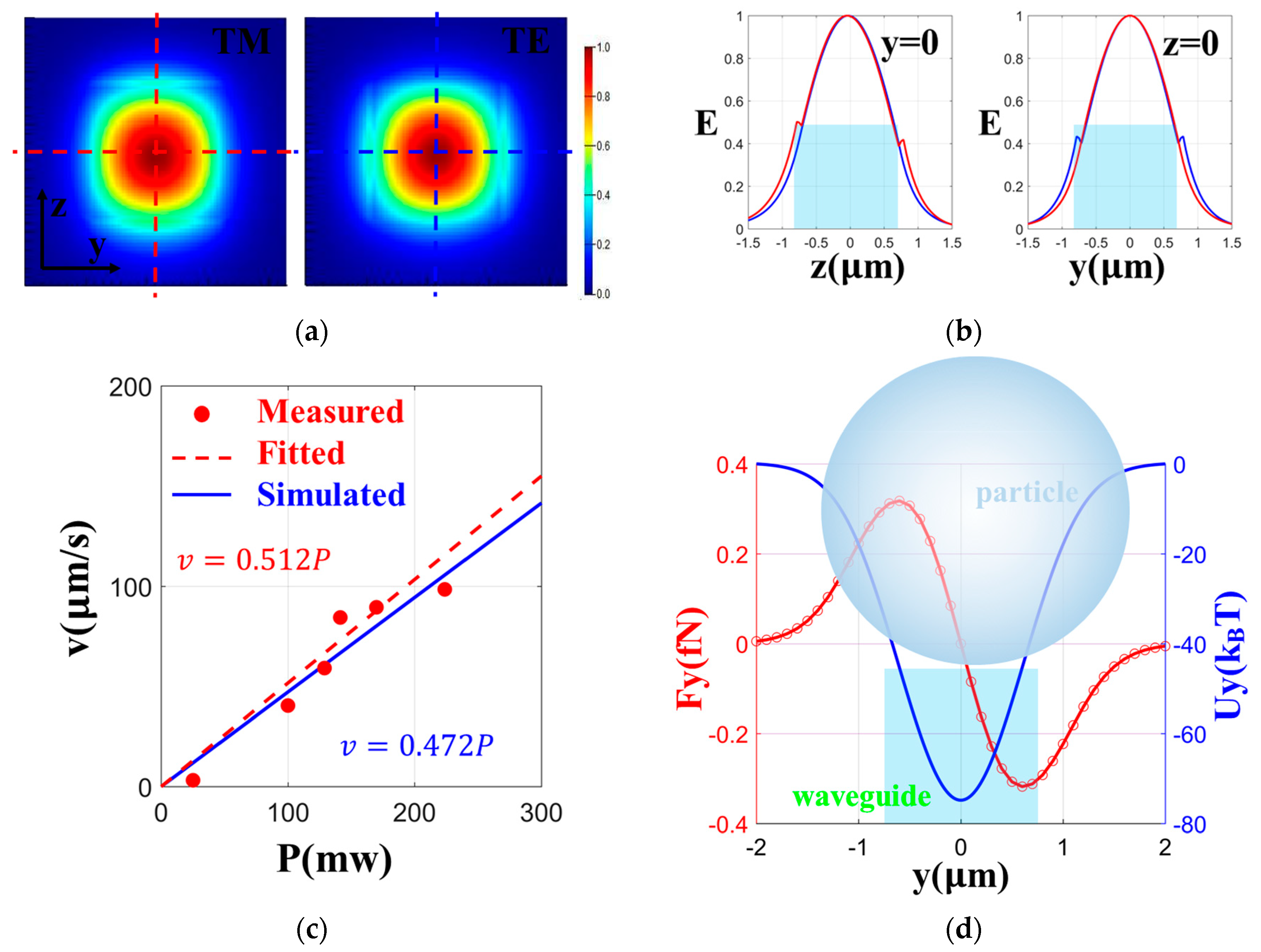
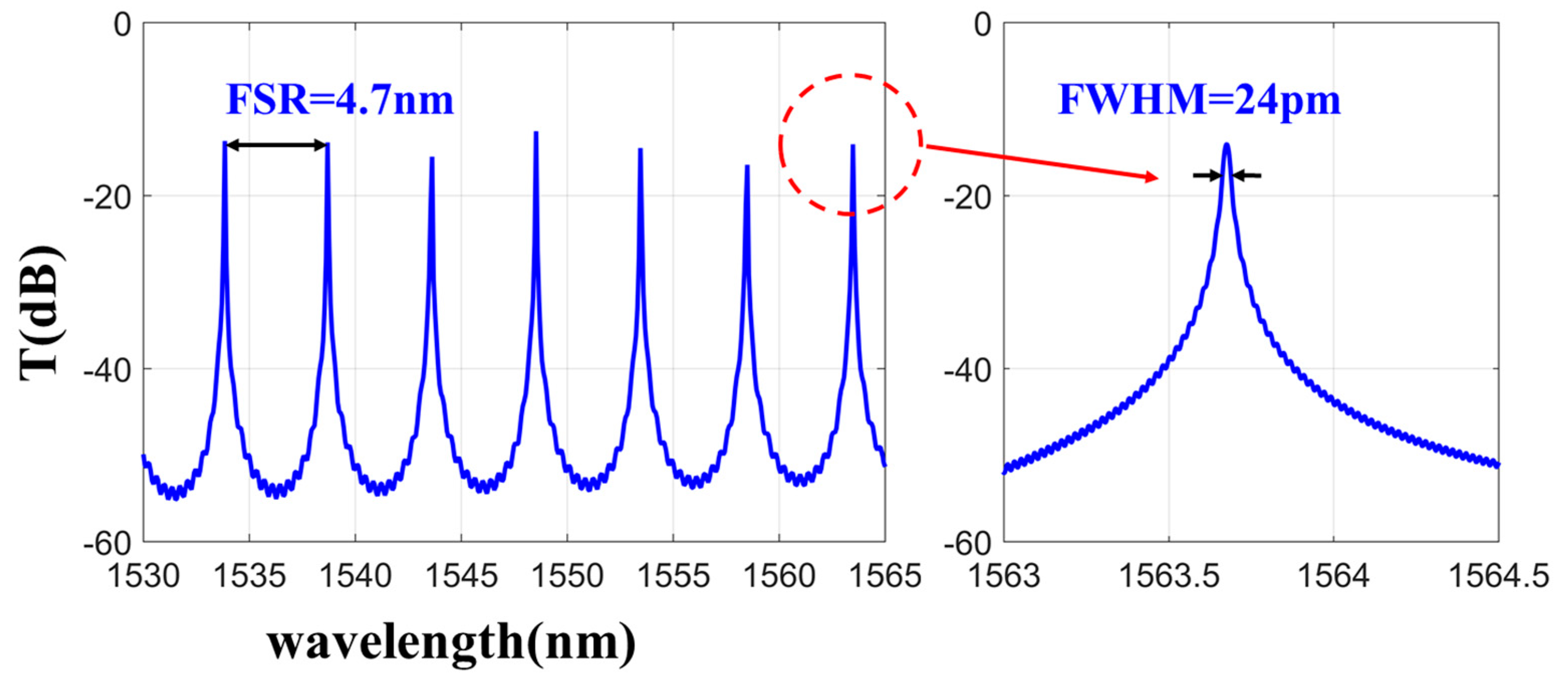
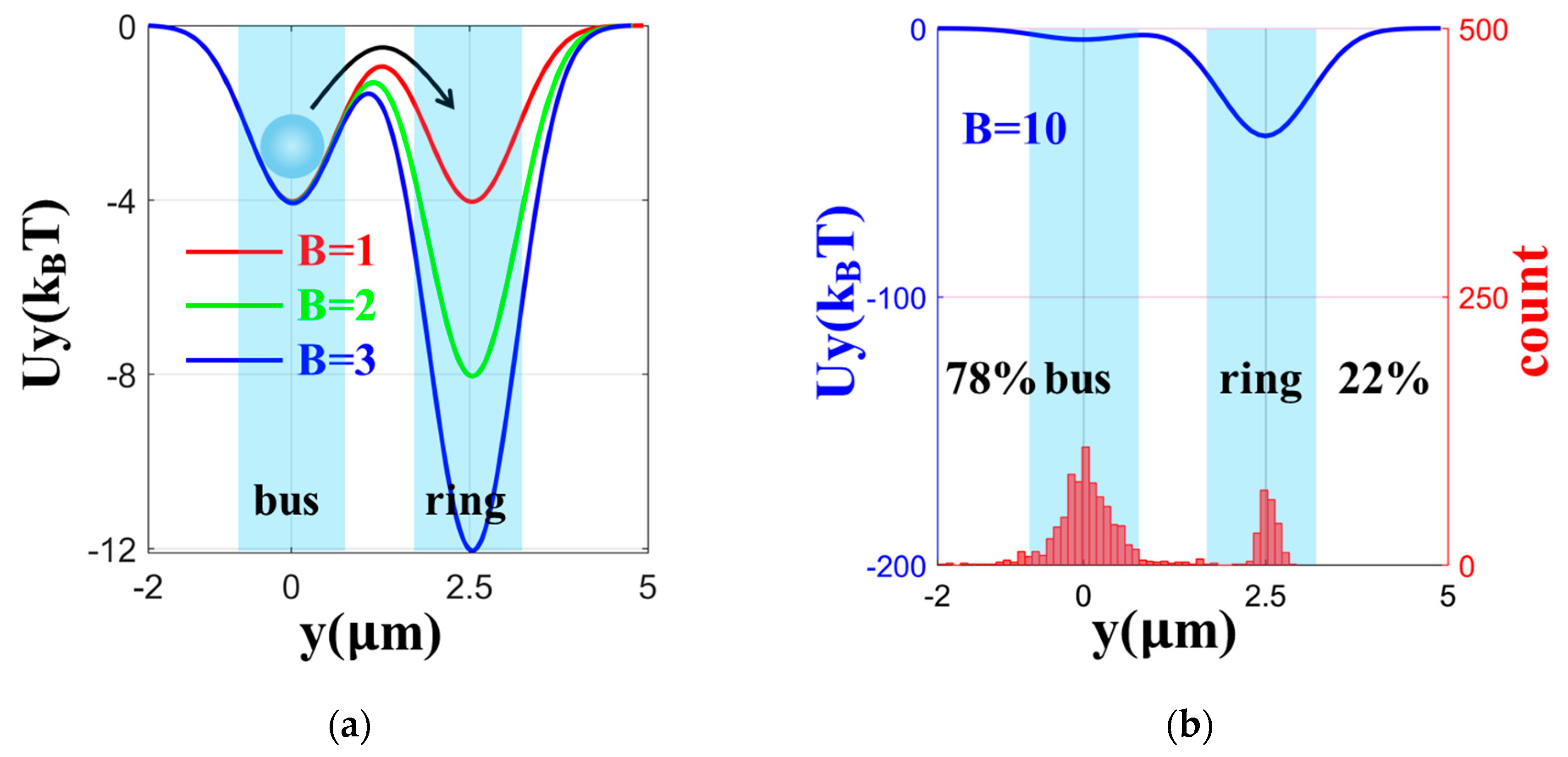
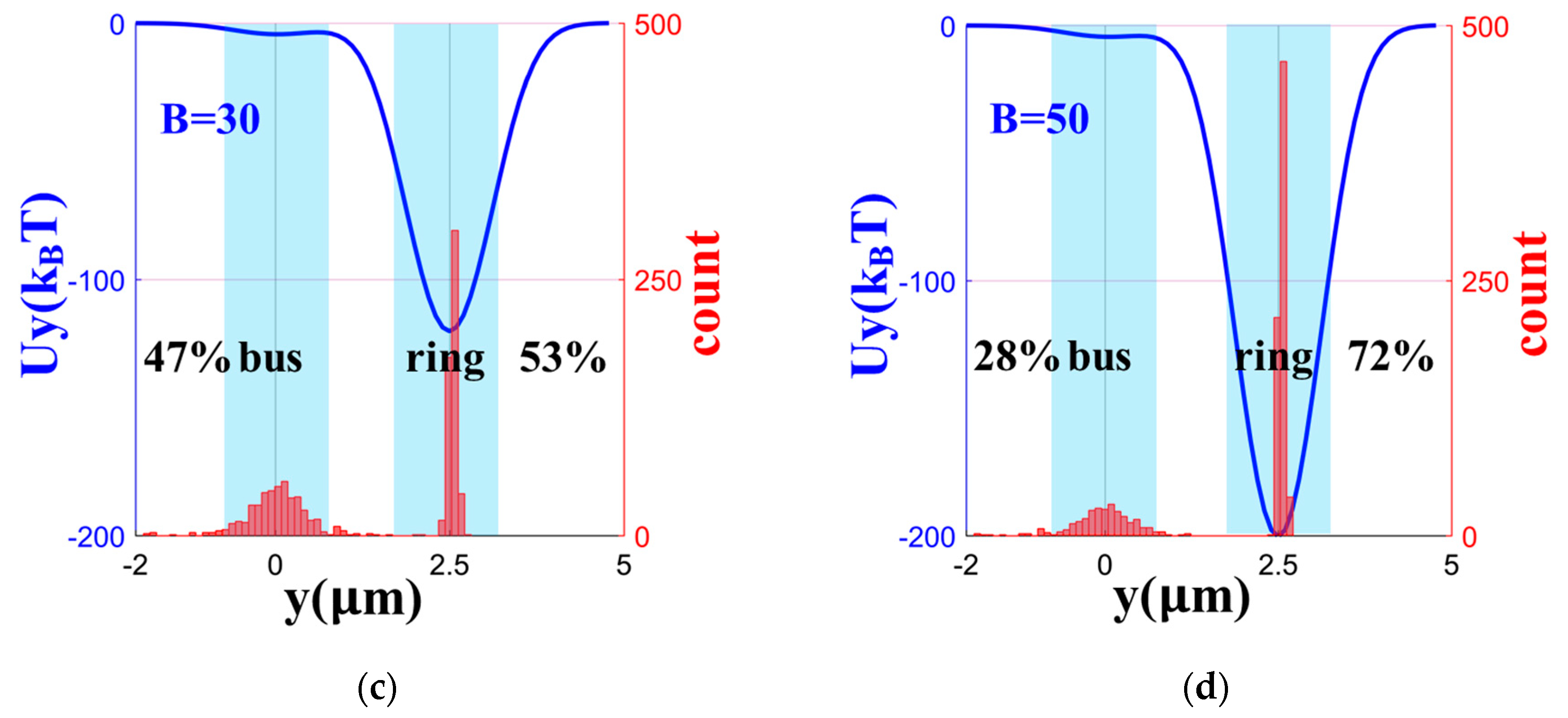
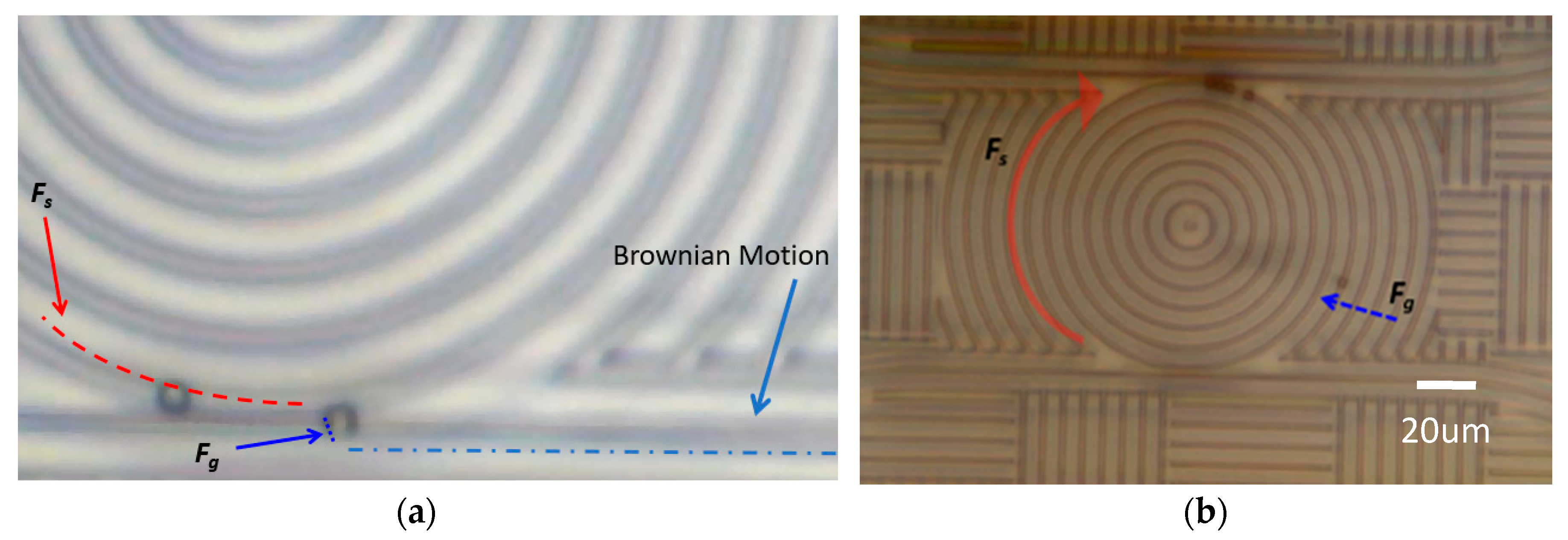
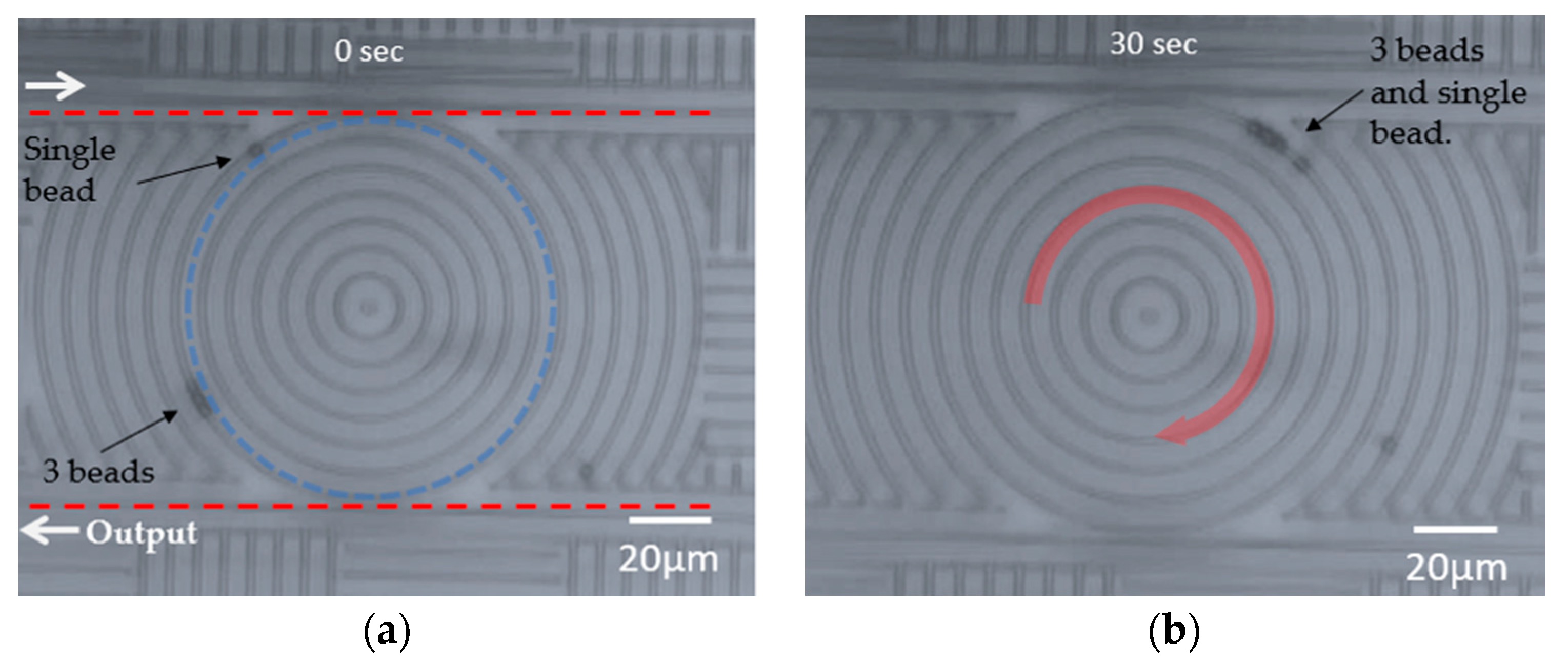

| Resonance Wavelength (nm) | Average Power in the Input Waveguide (dBm) | Average Power in the Resonator (dBm) | Location of the Particle | Trapping Speed (μm/s) |
| 1555.35 | 14.1 | N/A | Bus | 3.13 |
| 1555.35 | 14.1 | 20.0 | Ring | 40.4 |
| 1555.38 | 15.1 | 21.1 | Ring | 59.1 |
| 1555.39 | 15.5 | 21.5 | Ring | 84.4 |
| 1555.40 | 16.3 | 22.3 | Ring | 89.5 |
| 1555.41 | 17.5 | 23.5 | Ring | 98.4 |
© 2020 by the authors. Licensee MDPI, Basel, Switzerland. This article is an open access article distributed under the terms and conditions of the Creative Commons Attribution (CC BY) license (http://creativecommons.org/licenses/by/4.0/).
Share and Cite
Ho, V.W.L.; Chang, Y.; Liu, Y.; Zhang, C.; Li, Y.; Davidson, R.R.; Little, B.E.; Wang, G.; Chu, S.T. Optical Trapping and Manipulating with a Silica Microring Resonator in a Self-Locked Scheme. Micromachines 2020, 11, 202. https://doi.org/10.3390/mi11020202
Ho VWL, Chang Y, Liu Y, Zhang C, Li Y, Davidson RR, Little BE, Wang G, Chu ST. Optical Trapping and Manipulating with a Silica Microring Resonator in a Self-Locked Scheme. Micromachines. 2020; 11(2):202. https://doi.org/10.3390/mi11020202
Chicago/Turabian StyleHo, Victor W. L., Yao Chang, Yang Liu, Chi Zhang, Yuhua Li, Roy R. Davidson, Brent E. Little, Guanghui Wang, and Sai T. Chu. 2020. "Optical Trapping and Manipulating with a Silica Microring Resonator in a Self-Locked Scheme" Micromachines 11, no. 2: 202. https://doi.org/10.3390/mi11020202
APA StyleHo, V. W. L., Chang, Y., Liu, Y., Zhang, C., Li, Y., Davidson, R. R., Little, B. E., Wang, G., & Chu, S. T. (2020). Optical Trapping and Manipulating with a Silica Microring Resonator in a Self-Locked Scheme. Micromachines, 11(2), 202. https://doi.org/10.3390/mi11020202






